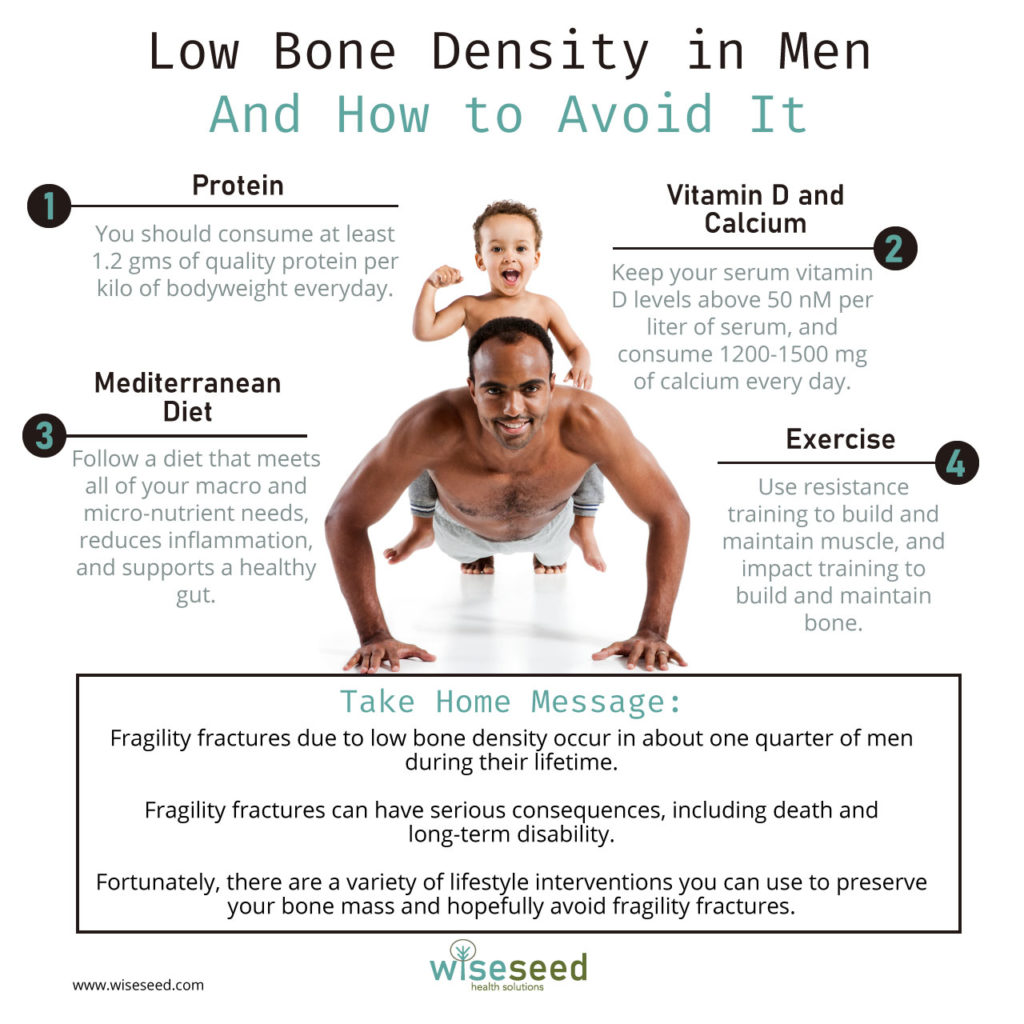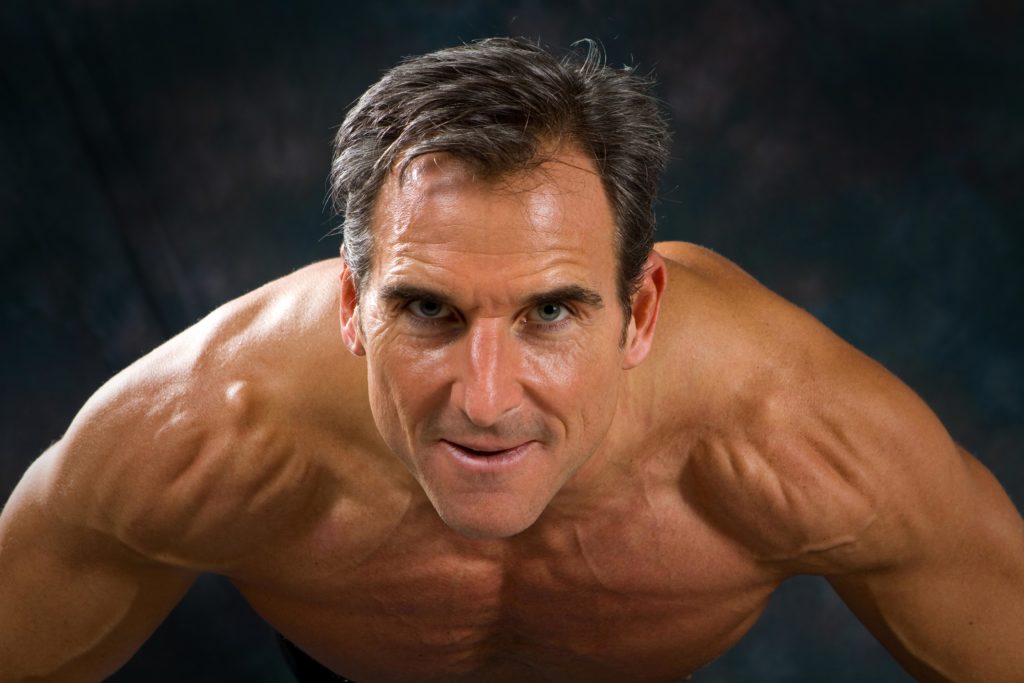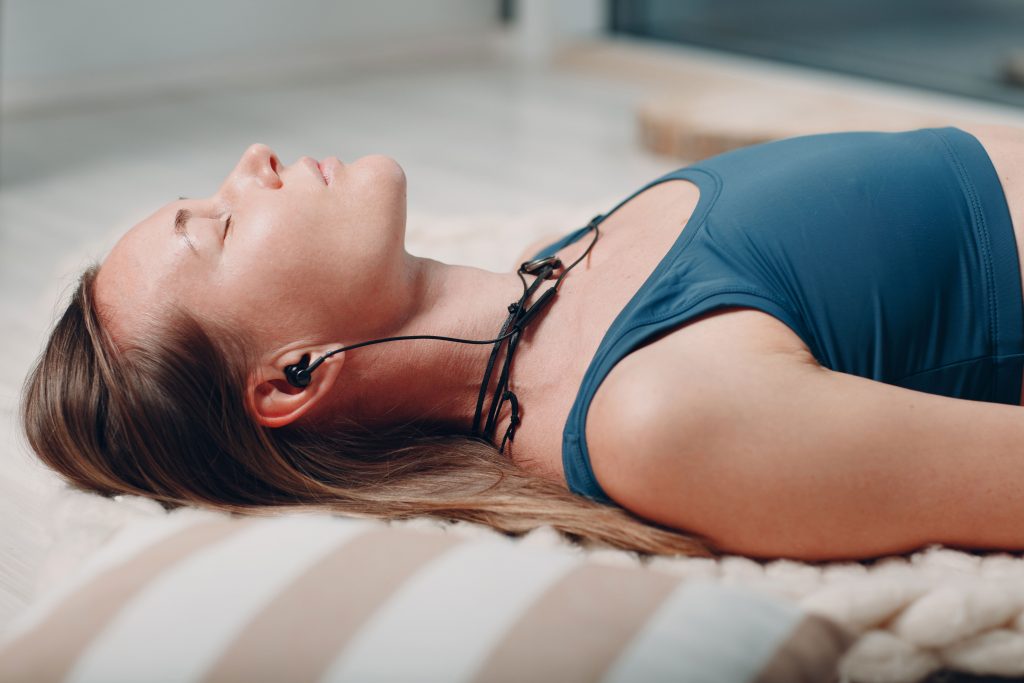Low Bone Density in Men, and How to Avoid It.

“It is health that is the real wealth, and not pieces of
gold and silver.” – Mahatma Gandhi
Do men really suffer from fragile bones?
Low bone density remains a major health issue for women. And for good reason, as it’s estimated that as many as one in two women will experience a fragility fracture in their lifetime (1).
However, men also suffer from fragile bones as they age (1, 2). In fact, around one in four men will experience a fragility fracture before they die (1). For reasons currently unknown, men are more likely to die or experience significant disability after their fracture (2). For example, 25-35% of older men die within a year of suffering a hip fracture (2). This is about twice the mortality rate of women (2).
Thus, men clearly do experience bone fragility as they age. Further, the consequences of low bone density for men are particularly grave, as it incurs a high risk of death or long-term disability.
Bone density, bone architecture, and bone turnover: the three factors to strong bones.
There are three key design features responsible for bone strength (3).
1, Bone Density and Flexibility
The calcium and phosphorous in your bones endows your bones with the rigidity required to bear weight and resist compressive forces (3). The second critical structural component of your bones is collagen. Collagen makes your bones flexible, which protects your bones from breaking while being stretched, twisted, and bent (3).
2. Bone Design
Evolution has selected a bone design of exceptional strength and functionality. The complexity of bone architecture is beyond the scope of this article. Suffice it to say that the structure of your bone is highly organized, with bone fibers arranged in the directions to counteract the stressors that you most commonly encounter (3).
3. Bone Turnover
The final master stroke that underpins your bone strength is turnover. Your bones are constantly being turned over (3). This means that old bone is constantly being degraded and replaced by new bone. It is bone turnover that makes bone such a highly adaptive structure. For example, continual bone turnover allows your bones to quickly adapt to the new stress and get stronger (3).
Unfortunately, bone turnover imposes two major trade-offs. The first trade-off is that bone deposition, the part of the bone turnover program that lays down new bone bones, requires mechanical stress to stay active (3). If mechanical stress is reduced, bone deposition decreases, and your bone strength begins to decline. This is what happens to astronauts who are in zero gravity, to people who are bedridden for extended periods, or to those who suffer a spinal injury. The second trade-off is that you need to maintain sufficient levels of nutrition to support the deposition of new bone (3). That’s why people with diets low in protein or calcium often suffer from fragile bones.
Risk Factors for Fragile Bones
There are many risk factors that can contribute to fragile bones. Table One summarizes the major ones that you can control (2).
| A Low Protein Diet |
| Insufficient Calcium, Vitamin D, Magnesium, and other micro-nutrient/minerals |
| Low Physical Activity |
| Low Muscle Mass and/or Low Muscle Strength (sarcopenia) |
| Alcohol Abuse |
| Smoking |
| Low or high BMI (i.e. underweight or obese) |
| Chronic Inflammation |
Avoiding Low Bone Density
The key for maintaining high bone density is to maintain a positive bone turnover. Fortunately, for most people this is a simple process. Simple, but not easy.
1. Diet
A nutritious and balanced diet is essential to maintain your bone turnover in a positive state. However, there are a few critical aspects to focus on for optimal bone health.
First, you need to consume sufficient high-quality protein (2). As you get older, your body becomes less efficient at utilizing protein, a syndrome known as anabolic resistance (4). To overcome anabolic resistance, older adults should be consuming at least 1.2 g/kg of high-quality protein every day (4).
It’s well known that adequate vitamin D and calcium intake is essential for maintaining bone mass. But how much vitamin D and calcium should you take? As for calcium, you need to be consuming 1200-1500 mg of calcium every day (2)!
With respect to vitamin D, consider the studies undertaken on recruits undergoing Royal Marine (RM) training in the United Kingdom, which found that serum vitamin D below 50 nmol per liter was associated with i) an increased risk of stress fracture (5) and ii) a slower recovery from stress fracture (6). Unfortunately, serum vitamin D levels below 50 nmol per liter are common in older men. This low vitamin D in older males is associated with a higher rate of falls and fragility fractures.
Ideally, you would get all your micro-nutrients and vitamin D from a healthy, balanced diet and sun exposure. Because many of us don’t live in an ideal world, we need to supplement. Daily vitamin D supplementation of 800–1000 IU (20–25 μg) is recommended, while daily calcium supplementation in the 500–1000 mg range is appropriate for older men at risk of calcium deficiency (2).
2. Inflammation and Gut Health
Chronic inflammation negatively impacts bone health (7). Fortunately, the Mediterranean diet reduces inflammation while supporting a healthy gut flora. This is important, because a healthy gut flora improves bone health by increasing your ability to absorb calcium and by producing bioactive compounds that help improve bone density. Finally, let’s not forget that the Mediterranean diet also provides all the essential minerals, micro-nutrients and vitamins that you need for optimal health.
3. Exercise
Your bones require mechanical stress to stay strong. This can only be provided by physical activity. Here we recommend two types of exercise, i) resistance training to build muscle mass and strength, and ii) impact training to build strong bones.
Resistance Training
Maintaining your muscle strength and mass as you age is important for two reasons. First, strong muscles generate powerful mechanical stress on your bones, which keeps your bones strong. Second, strong muscles greatly reduce your chance of falling, which is the most common cause of fragility fracture in older adults. Any type of resistance training that follows the principles of progressive overload and focuses and basic pushing and pulling movements will do the trick. Barbell, dumbbell, kettlebell, bands, callisthenics, or machines. Pick the style you like and hit it hard 2-3 times a week.
Impact Training
Many studies have shown that exercises and activities involving impact can improve bone density. We’ve already outlined some impact training approaches for both upper and lower body. However, there are two other forms of impact training that worth mentioning.
For your lower body, consider sprinting, and for your upper body, consider heavy bag training. We’ve covered the benefits of sprinting in depth. The are several advantages of sprinting. It improves your lower body bone density, improves your muscle mass, helps you lose fat, and increases your cardiovascular fitness. Not too shabby!
Just be aware that sprinting does carry an inherent risk of injury. To avoid injury, be sure to read our articles on preparing your hamstrings and calves for sprinting before you dive in.
Note that sprinting in the context of sport is great for improving bone density. This is because you are constantly changing direction while sprinting. This imposes stress on your bones from multiple angles, all the while increasing your skills and co-ordination. Examples such as soccer, basketball, squash, tennis, and other sports that involve sprinting and direction change are all great options.
Finally, I was overjoyed to discover that hitting the heavy bag improves the bone density of your upper body (8). Like sprinting, heavy bag workouts also improve many other physical attributes in addition to bone density. These include increased endurance, power, coordination, and fat loss. For hitting the heavy bag effectively and without injury, I recommend finding a good striking coach, and gradually increase your intensity over time.
As you can see, there are plenty of fantastic impact training options to choose from. Just remember that bones take time to recover from impact training. Therefore, we recommend impact training to 2-3 times a week, with at least one day of rest in between impact training sessions.
Take Home Message
The primary message is that men also suffer from low bone density. Moreover, men are more likely to die or experience significant disability after a fragility fracture compared to women. Despite this, low bone density is under-diagnosed and under-treated in men. This is true even for men who have already experienced a fragility fracture (1)! Fortunately, following the simple guidelines outlined in this article will help keep your bones strong.
Click on the link below to receive your free PDF.

References and Further Reading
1. S. Ramachandran et al., Gender Disparities in Osteoporosis Screening and Management Among Older Adults. Adv Ther, (2021).
2. J. M. Kaufman, Management of osteoporosis in older men. Aging Clin Exp Res, (2021).
3. N. H. Hart et al., Biological basis of bone strength: anatomy, physiology and measurement. J Musculoskelet Neuronal Interact 20, 347-371 (2020).
4. K. J. M. Paulussen et al., Anabolic Resistance of Muscle Protein Turnover Comes in Various Shapes and Sizes. Front Nutr 8, 615849 (2021).
5. T. Davey et al., Low serum 25-hydroxyvitamin D is associated with increased risk of stress fracture during Royal Marine recruit training. Osteoporos Int 27, 171-179 (2016).
6. T. Richards, C. Wright, British Army recruits with low serum vitamin D take longer to recover from stress fractures. BMJ Mil Health 166, 240-242 (2020).
7. S. Epsley et al., The Effect of Inflammation on Bone. Front Physiol 11, 511799 (2020).
8. C. Lambert, B. R. Beck, A. T. Harding, S. L. Watson, B. K. Weeks, Regional changes in indices of bone strength of upper and lower limbs in response to high-intensity impact loading or high-intensity resistance training. Bone 132, 115192 (2020).
Acknowledgements
Images provided by RomarioIen and xalanx
Disclaimer
The material displayed on this website is provided without any guarantees, conditions or warranties as to its accuracy.
Information written and expressed on this website is for education purposes and interest only. It is not intended to replace advice from your medical or healthcare professional.
You are encouraged to make your own health care choices based on your own research and in conjunction with your qualified practitioner.
The information provided on this website is not intended to provide a diagnosis, treatment or cure for any diseases. You should seek medical attention before undertaking any diet, exercise, other health program or other procedure described on this website.
To the fullest extent permitted by law we hereby expressly exclude all warranties and other terms which might otherwise be implied by statute, common law or the law of equity and must not be liable for any damages whatsoever, including but without limitation to any direct, indirect, special, consequential, punitive or incidental damages, or damages for loss of use, profits, data or other intangibles, damage to goodwill or reputation, injury or death, or the cost of procurement of substitute goods and services, arising out of or related to the use, inability to use, performance or failures of this website or any linked sites and any materials or information posted on those sites, irrespective of whether such damages were foreseeable or arise in contract, tort, equity, restitution, by statute, at common law or otherwise.

Ten Minutes is All You Need
Research has shown that ten minutes of moderate-to-vigorous exercise performed each day is enough to significantly reduce your risk of early death.





